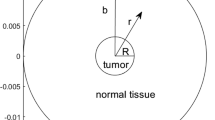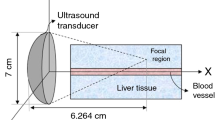Abstract
Numerical schemes based on the immersed boundary method (IBM) offer the advantages of avoiding the body-conformal structured or unstructured grid generation process in the complex tumor morphology. This study uses the finite-volume immersed boundary method (FV-IBM) to solve bioheat physics in actual liver tumor tissue. IBM is employed in this methodology to enforce the boundary effect on the non-body conformal Cartesian grid. The finite-volume method (FVM) is used as a numerical technique to discretize the governing equations. The validation and verification of the FV-IB method have shown that the scheme is second-order accurate. Furthermore, the numerical results in the spherical tumor model are in good agreement with previously reported results for steady and transient cases. Results for MNPs-based hyperthermia investigation with two heat source (Gaussian and uniform) distribution patterns in the liver tumor are in good agreement with the numerical solution of COMSOL Multiphysics. Thus, a simple and robust FV-IBM-based numerical scheme is proposed to solve the bioheat models in arbitrary tissue shapes.
















Similar content being viewed by others
Data availability statement
All data generated or analysed during this study are included in this published article.
References
Becker SM, Kuznetsov AV (2015) Heat transfer and fluid flow in biological processes. Elsevier Science Publishing, Cambridge. https://doi.org/10.1016/C2012-0-03651-4
Fedorov A, Beichel R, Kalpathy-Cramer J et al (2012) 3D Slicer as an image computing platform for the quantitative imaging network. Magn Reson Imaging 30:1323–1341. https://doi.org/10.1016/j.mri.2012.05.001
Bellizzi G, Buci O (2018) Magnetic nanoparticle hyperthermia. In: Crocco L, Karanasiou I, James M, Conceição R (eds) Emerging electromagnetic technologies for brain diseases diagnostics, monitoring and therapy, 1st edn. Springer, Cham, pp 129–219. https://doi.org/10.1007/978-3-319-75007-1_6
Krawczyk PM, Eppink B, Essers J et al (2011) Mild hyperthermia inhibits homologous recombination, induces BRCA2 degradation, and sensitizes cancer cells to poly (ADP-ribose) polymerase-1 inhibition. Proc Natl Acad Sci 108:9851–9856. https://doi.org/10.1073/pnas.1101053108
Horsman MR, Overgaard J (2007) Hyperthermia: a potent enhancer of radiotherapy. J Clin Oncol 19:418–426. https://doi.org/10.1016/j.clon.2007.03.015
Feng Y, Fuentes D, Hawkins A, Bass J, Rylander MN, Elliott A, Shetty A, Stafford RJ, Oden JT (2008) Nanoshell-mediated laser surgery simulation for prostate cancer treatment. Eng Comput 25:3–13. https://doi.org/10.1007/s00366-008-0109-y
Kumar CSSR, Mohammad F (2011) Magnetic nanomaterials for hyperthermia-based therapy and controlled drug delivery. Adv Drug Deliv Rev 63:789–808. https://doi.org/10.1016/j.addr.2011.03.008
Yarmolenko PS, Moon EJ, Landon C, Manzoor A, Hochman DW, Viglianti BL, Dewhirst MW (2011) Thresholds for thermal damage to normal tissues: an update. Int J Hyperthermia 27:320–343. https://doi.org/10.3109/02656736.2010.534527
Mittal ER, Iaccarino G (2005) Immersed boundary methods. Annu Rev Fluid Mech 37:239–261. https://doi.org/10.1146/annurev.fluid.37.061903.175743
Péron S, Benoit C, Renaud T, Mary I (2020) An immersed boundary method on Cartesian adaptive grids for the simulation of compressible flows around arbitrary geometries. Eng Comput 37:2419–2437. https://doi.org/10.1007/s00366-020-00950-y
3D Slicer [Internet]. https:// www.slicer.org/. Accessed 10 Aug 2022
Das S, Panda A, Deen NG, Kuipers JAM (2018) A sharp-interface immersed boundary method to simulate convective and conjugate heat transfer through highly complex periodic porous structures. Chem Eng Sci 191:1–18. https://doi.org/10.1016/j.ces.2018.04.061
Pennes HH (1948) Analysis of tissue and arterial blood temperatures in the resting human forearm. J Appl Physiol 1:93–122. https://doi.org/10.1152/jappl.1948.1.2.93
Versteeg HK, Malalasekera W (2007) An introduction to computational fluid dynamics: the finite volume method. Pearson Education, India. ISBN 8131720489
Cooper GM (2000) The Development and Causes of Cancer In: The cell: a molecular approach 2nd edn. Sinauer Associates, Sunderland (MA). https://www.ncbi.nlm.nih.gov/books/NBK9963/
Byrd BK, Krishnaswamy V, Gui J, Rooney T, Zuurbier R, Rosenkranz K, Paulsen K, Barth RJ (2020) The shape of breast cancer. Breast Cancer Res Treat 183:403–410. https://doi.org/10.1007/s10549-020-05780-6
Bassett LW, Lee-Felker S (2018) Breast imaging screening and diagnosis. In: Bland K, Copeland E, Klimberg V, Gradishar W (eds) The breast, 5th edn. Elsevier, Amsterdam, pp 337–361. https://doi.org/10.1016/B978-0-323-35955-9.00026-X
Kumar M, Roy S (2016) A sharp interface immersed boundary method for moving geometries with mass conservation and smooth pressure variation. Comput fluids 137:15–35. https://doi.org/10.1016/j.compfluid.2016.07.008
Kumar M, Roy S, Ali M (2016) An efficient immersed boundary algorithm for simulation of flows in curved and moving geometries. Comput Fluids 129:159–178. https://doi.org/10.1016/j.compfluid.2016.02.009
Gilmanov A, Sotiropoulos F (2005) A hybrid Cartesian/immersed boundary method for simulating flows with 3D, geometrically complex, moving bodies. J Comput Phys 207:457–492. https://doi.org/10.1016/j.jcp.2005.01.020
Mark A, Rundqvist R, Edelvik F (2011) Comparison between different immersed boundary conditions for simulation of complex fluid flows. Fluid Dyn Mater Process 7:241–258. https://doi.org/10.3970/fdmp.2011.007.241
Mark A, Van Wachem BGM (2008) Derivation and validation of a novel implicit second-order accurate immersed boundary method. J Comput Phys 227:6660–6680. https://doi.org/10.1016/j.jcp.2008.03.031
Municchi F, Radl S (2017) Consistent closures for Euler–Lagrange models of bi-disperse gas-particle suspensions derived from particle-resolved direct numerical simulations. Int J Heat Mass Transf 111:171–190. https://doi.org/10.1016/j.ijheatmasstransfer.2017.03.122
Clark K, Vendt B, Smith K, Freymann J, Kirby J, Koppel P, Moore S, Phillips S, Maffitt D, Pringle M, Tarbox L, Prior F (2013) The Cancer Imaging Archive (TCIA): maintaining and operating a public information repository. J Digit Imaging 26:1045–1057. https://doi.org/10.1007/s10278-013-9622-7
Doshi JB (2010) Differential equations for scientists and engineers. Narosa Publishing House, India
Kumar N, Singh S, Doshi JB (2013) Nodal integral method using quadrilateral elements for transport equations: part 1—convection-diffusion equation. Numer Heat Transfer Part B Fundam 64:1–21. https://doi.org/10.1080/10407790.2013.784125
Salloum M, Ma R, Zhu L (2009) Enhancement in treatment planning for magnetic nanoparticle hyperthermia: optimization of the heat absorption pattern. Int J Hyperthermia 25:309–321. https://doi.org/10.1080/02656730902803118
Lin CT, Liu KC (2009) Estimation for the heating effect of magnetic nanoparticles in perfused tissues. Int Commun Heat Mass Transf 36:241–244. https://doi.org/10.1016/j.icheatmasstransfer.2008.11.006
Golneshan AA, Lahonian M (2011) The effect of magnetic nanoparticle dispersion on temperature distribution in a spherical tissue in magnetic fluid hyperthermia using the lattice Boltzmann method. Int J Hyperthermia 27:266–274. https://doi.org/10.3109/02656736.2010.519370
Attaluri A, Ma R, Qiu Y, Li W, Zhu L (2011) Nanoparticle distribution and temperature elevations in prostatic tumours in mice during magnetic nanoparticle hyperthermia. Int J Hyperthermia 27:491–502. https://doi.org/10.3109/02656736.2011.584856
He X, McGee S, Coad J, Schmidlin F, Iaizzo P, Swanlund DJ, Kluge S, Rudie E, Bischof J (2004) Investigation of the thermal and tissue injury behaviour in microwave thermal therapy using a porcine kidney model. Int J Hyperthermia 20:567–593. https://doi.org/10.1080/0265673042000209770
Pearce JA (2009) Relationship between Arrhenius models of thermal damage and the CEM 43 thermal dose. Energy-Based Treat Tissue Assess 7181:718104. https://doi.org/10.1117/12.807999
Schutt DJ, Haemmerich D (2008) Effects of variation in perfusion rates and of perfusion models in computational models of radio frequency tumor ablation. Med Phys 35:3462–3470. https://doi.org/10.1118/1.2948388
Soetaert F, Dupré L, Ivkov R, Crevecoeur G (2015) Computational evaluation of amplitude modulation for enhanced magnetic nanoparticle hyperthermia. Biomed Eng 60:491–504. https://doi.org/10.1515/bmt-2015-0046
Vaupel P, Kallinowski F, Okunieff P (1989) Blood flow, oxygen and nutrient supply, and metabolic microenvironment of human tumors. A Review, Cancer Res 49:6449–6465
Singh G, Kumar N, Avti P (2020) Computational evaluation of effectiveness for intratumoral injection strategies in magnetic nanoparticle assisted thermotherapy. Int J Heat Mass Transfer 148:119129. https://doi.org/10.1016/j.ijheatmasstransfer.2019.119129
Singh A, Kumar N (2022) Parameterizing the effects of tumor shape in magnetic nanoparticle thermotherapy through a computational approach. J Heat Transfer 144:1–12. https://doi.org/10.1115/1.4052967
Salloum M, Ma RH, Weeks D, Zhu L (2008) Controlling nanoparticle delivery in magnetic nanoparticle hyperthermia for cancer treatment: experimental study in agarose gel. Int J Hyperthermia 24:337–345. https://doi.org/10.1080/02656730801907937
Siauve N, Nicolas L, Vollaire C, Marchal C (2004) Optimization of the sources in local hyperthermia using a combined finite element-genetic algorithm method. Int J Hyperthermia 20:815–833. https://doi.org/10.1080/02656730410001711664
Nain S, Kumar N, Avti PK (2022) Computational investigation of the tumor position and ambient conditions on magnetic nanoparticle thermo-therapy. Therm Sci Eng Prog 34:101396. https://doi.org/10.1016/j.tsep.2022.101396
Nain S, Kumar N, Chudasama B, Avti PK (2023) The SLP estimation of the nanoparticle systems using size-dependent magnetic properties for the magnetic hyperthermia therapy. J Magn Magn Mater 565:170219. https://doi.org/10.1016/j.jmmm.2022.170219
Acknowledgements
The research is performed in partial fulfillment of the requirements for PhD degree by Amritpal Singh from Thapar Institute of Engineering and Technology (TIET) Patiala.
Funding
This research received no specific grant from the public, commercial, or not-for-profit funding agencies.
Author information
Authors and Affiliations
Corresponding author
Ethics declarations
Conflict of interest
The authors declare that they have no known competing financial interests or personal relationships that could have appeared to influence the work reported in this paper. The authors also declare that they do not have any financial interests/personal relationships, which may be considered as potential competing interests.
Ethical approval
Ethical approval does not apply to this manuscript.
Additional information
Publisher's Note
Springer Nature remains neutral with regard to jurisdictional claims in published maps and institutional affiliations.
Appendix
Appendix
\(\left({A}_{p}-{\chi }_{e}{\alpha }_{e} {A}_{e}- {\chi }_{w}{\alpha }_{w} {A}_{w} -{\chi }_{n}{\alpha }_{n} {A}_{n}- {\chi }_{s}{\alpha }_{s} {A}_{s}\right){T}_{p}^{t+1}= (\left(1-{\chi }_{e}\right){A}_{e}+ {\chi }_{w}{\beta }_{w} {A}_{w}){T}_{e}^{t+1}+(\left(1-{\chi }_{w}\right){A}_{w}{+{\chi }_{e}{\beta }_{e} {A}_{e}) T}_{w}^{t+1}+ (\left(1-{\chi }_{n}\right){A}_{e}+ {\chi }_{s}{\beta }_{s} {A}_{s}){T}_{n}^{t+1}+((1-{\chi }_{s}){A}_{s}{+{\chi }_{n}{\beta }_{n} {A}_{n}) T}_{s}^{t+1}+ {B}_{p}+{\chi }_{e}{\gamma }_{e}{A}_{e}+ {\chi }_{w}{\gamma }_{w}{A}_{w}+{\chi }_{n}{\gamma }_{n}{A}_{n}+ {\chi }_{s}{\gamma }_{s}{A}_{s}\) A.1
For \({p}_{1}\) IB node (as shown in Fig. 1).
For east and north nodes: \({\chi }_{e}=1\) and \({\chi }_{n}\) \(=\) 1.
For west and south nodes: \({\chi }_{w}=0\) and \({\chi }_{s}\) \(=\) 0.
\(\left({A}_{p}-{\alpha }_{e} {A}_{e}- {\alpha }_{n} {A}_{n}\right){T}_{p}^{t+1}= ({A}_{w}{+{\beta }_{e} {A}_{e}) T}_{w}^{t+1}+({A}_{s}{+{\beta }_{n} {A}_{n}) T}_{s}^{t+1}+{B}_{p}+{\gamma }_{e}{A}_{e}+{\gamma }_{n}{A}_{n}\) A.2
For regular node, the \(\chi\) value in all direction is zero (‘p’ node, shown in Fig. 1).
\({A}_{p}{T}_{p}^{t+1}= {A}_{e}{T}_{e}^{t+1}+{A}_{w}{ T}_{w}^{t+1}+ {A}_{n}{T}_{n}^{t+1}+{A}_{s}{ T}_{s}^{t+1}+ {B}_{p}\) A.3
Rights and permissions
Springer Nature or its licensor (e.g. a society or other partner) holds exclusive rights to this article under a publishing agreement with the author(s) or other rightsholder(s); author self-archiving of the accepted manuscript version of this article is solely governed by the terms of such publishing agreement and applicable law.
About this article
Cite this article
Singh, A., Kumar, N. A coupled finite-volume immersed boundary method for the simulation of bioheat transfer in 3D complex tumor. Engineering with Computers 39, 3743–3758 (2023). https://doi.org/10.1007/s00366-023-01797-9
Received:
Accepted:
Published:
Issue Date:
DOI: https://doi.org/10.1007/s00366-023-01797-9




